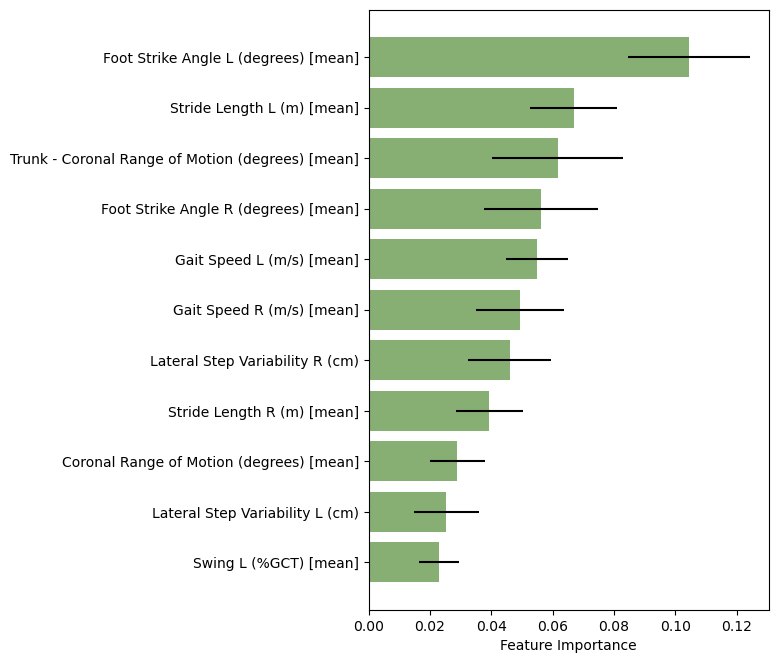Category: Parkinson’s Disease: Clinical Trials
Objective: This study compares the performance of machine learning classification models in predicting freezing of gait (FoG) from instrumented stand-and-walk trials in advanced Parkinson’s disease (PD) patients.
Background: FoG is one of the most debilitating motor symptoms impacting advanced PD patients; however, it is not well understood [1-2]. Machine learning has been studied to identify FoG episodes using wearable sensors [3-6]. However, these studies primarily focus on real-time FoG detection in the medication state.
Method: This study analyzed instrumented stand-and-walk (SAW) from advanced PD patients with STN-DBS. Each patient performed two SAW trials in their OFF Medication – OFF DBS state. For each trial, gait summary statistics from wearable sensors were analyzed by machine learning classification algorithms. These algorithms include random forest, support vector machines (SVM), and logistic regression. Each algorithm was tasked with identifying patients’ whose SAW trials UPDRS FoG score was non-zero as assessed by a trained movement disorder specialist. These algorithms’ performance was evaluated using leave-one-out cross-validation, wherein one patient is left out of training each fold and used for testing. Hyperparameter tuning was performed for each algorithm. Finally, feature ranking was performed using the Gini index of node impurities to identify gait features prioritized by the random forest model [7].
Results: A total of 21 PD subjects were evaluated (average age 64.24 years, 16 males, mean disease duration of 14 years) with 14 experiencing FoG in the unmedicated state. The mean and 95% confidence interval (CI) of each model’s accuracy and F1 score are presented in Table 1. Each model had statistically similar (p-value>0.05) performance based on a t-test. The random forest model’s top ten predictive gait features, based on the Gini index of node impurity, are presented in Figure 1.
Conclusion: These results indicate that machine learning, especially random forest, effectively classifies advanced PD patients as freezers/non-freezers based on SAW trials in their non-medicated/non-stimulated condition. The machine learning models not only rely on but utilize salient spatial and temporal gait features for FoG classification.
Table 1: Comparison of Machine Learning Models
Fig 1. Predictive Gait Features in Random Forest
References: [1] Okuma, Yasuyuki. “Freezing of gait in Parkinson’s disease.” Journal of neurology 253 (2006): vii27-vii32.
[2] Heremans, Elke, Alice Nieuwboer, and Sarah Vercruysse. “Freezing of gait in Parkinson’s disease: where are we now?.” Current neurology and neuroscience reports 13 (2013): 1-9.
[3] Borzì, Luigi, et al. “Prediction of freezing of gait in Parkinson’s disease using wearables and machine learning.” Sensors 21.2 (2021): 614.
[4] Sigcha, Luis, et al. “Deep learning approaches for detecting freezing of gait in Parkinson’s disease patients through on-body acceleration sensors.” Sensors 20.7 (2020): 1895.
[5] Li, Bochen, et al. “Improved deep learning technique to detect freezing of gait in Parkinson’s disease based on wearable sensors.” Electronics 9.11 (2020): 1919.
[6] Camps, Julià, et al. “Deep learning for freezing of gait detection in Parkinson’s disease patients in their homes using a waist-worn inertial measurement unit.” Knowledge-Based Systems 139 (2018): 119-131.
[7] Tan, Pang-Ning, Micahel Steinbach, and Vipin Kumar. “Introduction to data mining, Pearson education.” Inc., New Delhi (2006).
To cite this abstract in AMA style:
J. Watts, A. Khojandi, R. Ramdhani. Machine Learning Model Comparison for Freezing of Gait Prediction in Advanced Parkinson’s Disease Patients [abstract]. Mov Disord. 2024; 39 (suppl 1). https://www.mdsabstracts.org/abstract/machine-learning-model-comparison-for-freezing-of-gait-prediction-in-advanced-parkinsons-disease-patients/. Accessed December 7, 2025.« Back to 2024 International Congress
MDS Abstracts - https://www.mdsabstracts.org/abstract/machine-learning-model-comparison-for-freezing-of-gait-prediction-in-advanced-parkinsons-disease-patients/


